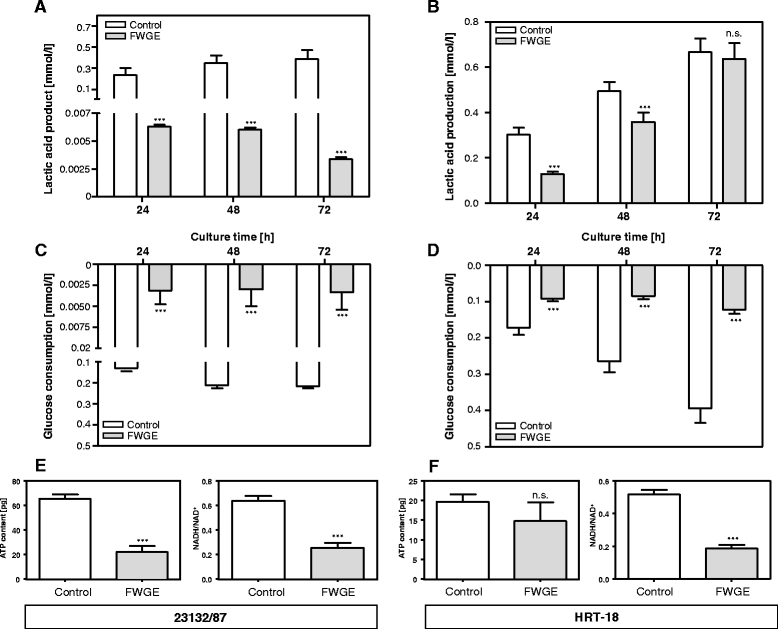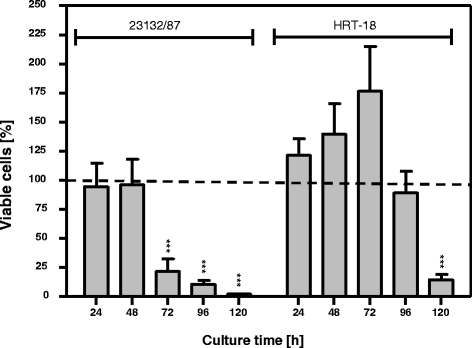Antiproliferative and antimetabolic effects behind the anticancer property of fermented wheat germ extract
- PMID: 27245162
- PMCID: PMC4888675
- DOI: 10.1186/s12906-016-1138-5
Antiproliferative and antimetabolic effects behind the anticancer property of fermented wheat germ extract
Abstract
Background: Fermented wheat germ extract (FWGE) sold under the trade name Avemar exhibits anticancer activity in vitro and in vivo. Its mechanisms of action are divided into antiproliferative and antimetabolic effects. Its influcence on cancer cell metabolism needs further investigation. One objective of this study, therefore, was to further elucidate the antimetabolic action of FWGE. The anticancer compound 2,6-dimethoxy-1,4-benzoquinone (DMBQ) is the major bioactive compound in FWGE and is probably responsible for its anticancer activity. The second objective of this study was to compare the antiproliferative properties in vitro of FWGE and the DMBQ compound.
Methods: The IC50 values of FWGE were determined for nine human cancer cell lines after 24 h of culture. The DMBQ compound was used at a concentration of 24 μmol/l, which is equal to the molar concentration of DMBQ in FWGE. Cell viability, cell cycle, cellular redox state, glucose consumption, lactic acid production, cellular ATP levels, and the NADH/NAD(+) ratio were measured.
Results: The mean IC50 value of FWGE for the nine human cancer cell lines tested was 10 mg/ml. Both FWGE (10 mg/ml) and the DMBQ compound (24 μmol/l) induced massive cell damage within 24 h after starting treatment, with changes in the cellular redox state secondary to formation of intracellular reactive oxygen species. Unlike the DMBQ compound, which was only cytotoxic, FWGE exhibited cytostatic and growth delay effects in addition to cytotoxicity. Both cytostatic and growth delay effects were linked to impaired glucose utilization which influenced the cell cycle, cellular ATP levels, and the NADH/NAD(+) ratio. The growth delay effect in response to FWGE treatment led to induction of autophagy.
Conclusions: FWGE and the DMBQ compound both induced oxidative stress-promoted cytotoxicity. In addition, FWGE exhibited cytostatic and growth delay effects associated with impaired glucose utilization which led to autophagy, a possible previously unknown mechanism behind the influence of FWGE on cancer cell metabolism.
Keywords: Autophagy; Benzoquinone; Cancer cells; Cytostatic; Cytotoxicity; FWGE; Reactive oxygen species.
Figures




Similar articles
-
The Effects of Adjuvant Fermented Wheat Germ Extract on Cancer Cell Lines: A Systematic Review.Nutrients. 2018 Oct 19;10(10):1546. doi: 10.3390/nu10101546. Nutrients. 2018. PMID: 30347664 Free PMC article.
-
Promising cytotoxic activity profile of fermented wheat germ extract (Avemar®) in human cancer cell lines.J Exp Clin Cancer Res. 2011 Apr 16;30(1):42. doi: 10.1186/1756-9966-30-42. J Exp Clin Cancer Res. 2011. PMID: 21496306 Free PMC article.
-
Characterizing the efficacy of fermented wheat germ extract against ovarian cancer and defining the genomic basis of its activity.Int J Gynecol Cancer. 2012 Jul;22(6):960-7. doi: 10.1097/IGC.0b013e318258509d. Int J Gynecol Cancer. 2012. PMID: 22740002 Free PMC article.
-
Fermented wheat germ extract--nutritional supplement or anticancer drug?Nutr J. 2011 Sep 5;10:89. doi: 10.1186/1475-2891-10-89. Nutr J. 2011. PMID: 21892933 Free PMC article.
-
The Medical Use of Wheatgrass: Review of the Gap Between Basic and Clinical Applications.Mini Rev Med Chem. 2015;15(12):1002-10. doi: 10.2174/138955751512150731112836. Mini Rev Med Chem. 2015. PMID: 26156538 Review.
Cited by
-
Wheat Germ Fermentation with Saccharomyces cerevisiae and Lactobacillus plantarum: Process Optimization for Enhanced Composition and Antioxidant Properties In Vitro.Foods. 2022 Apr 14;11(8):1125. doi: 10.3390/foods11081125. Foods. 2022. PMID: 35454712 Free PMC article.
-
Exploring the Anti-Cancer Effects of Fish Bone Fermented Using Monascus purpureus: Induction of Apoptosis and Autophagy in Human Colorectal Cancer Cells.Molecules. 2023 Jul 27;28(15):5679. doi: 10.3390/molecules28155679. Molecules. 2023. PMID: 37570647 Free PMC article.
-
Enzyme Treatment Alters the Anti-Inflammatory Activity of the Water Extract of Wheat Germ In Vitro and In Vivo.Nutrients. 2019 Oct 16;11(10):2490. doi: 10.3390/nu11102490. Nutrients. 2019. PMID: 31623257 Free PMC article.
-
[2,6-dimethoxy-1,4-benzoquinone alleviates dextran sulfate sodium-induced ulcerative colitis in mice by suppressing NLRP3 inflammasome activation].Nan Fang Yi Ke Da Xue Xue Bao. 2025 Aug 20;45(8):1654-1662. doi: 10.12122/j.issn.1673-4254.2025.08.10. Nan Fang Yi Ke Da Xue Xue Bao. 2025. PMID: 40916527 Free PMC article. Chinese.
-
Fermented Wheat Germ Protein with Histone Deacetylase Inhibitor AR42 Demonstrates Enhanced Cytotoxicity against Lymphoma Cells In Vitro and In Vivo.Int J Mol Sci. 2024 Jul 18;25(14):7866. doi: 10.3390/ijms25147866. Int J Mol Sci. 2024. PMID: 39063110 Free PMC article.
References
-
- Hidvégi M, Rásó E, Tömösközi-Farkas R, Paku S, Lapis K, Szende B. Effect of Avemar and Avemar + Vitamin C on tumor growth and metastasis in experimental animals. Anticancer Res. 1998;18:2353–8. - PubMed
-
- Demidov LV, Manziuk LV, Kharkevitch GY, Pirogova NA, Artamonova EV. Adjuvant fermented wheat germ extract (Avemar) nutraceutical improves survival of high risk skin melanoma patients: a randomized pilot phase II clinical study with a 7-year follow-up. Cancer Biother Radiopharm. 2008;23(4):477–82. doi: 10.1089/cbr.2008.0486. - DOI - PubMed
Publication types
MeSH terms
Substances
LinkOut - more resources
Full Text Sources
Other Literature Sources

